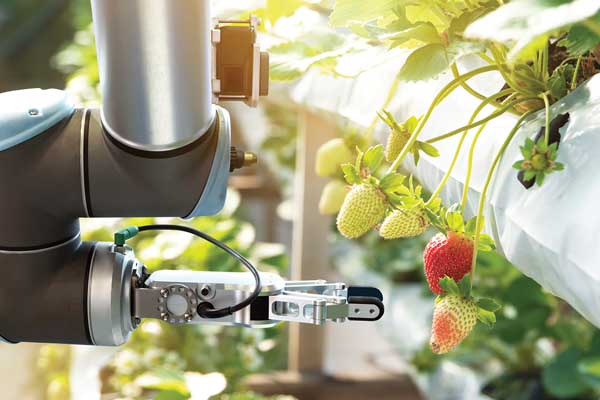Robots Toil From Farm to Fork
IFTNEXT

Initially tasked with pick-and-place jobs at the end of a food or beverage packaging line, robots are expanding their grasp throughout the food chain—from agricultural fields and food preparation to cooking and food delivery.
Robots can work in harsh (i.e., hot, humid or cold) environments, perform repetitive tasks that humans dislike, and they typically don’t harbor bacteria or pathogens that can contaminate food. Collaborative robots (called co-bots) can work together with humans to improve line productivity.
Improvements in machine vision, lower costs, and flexible and sanitary designs are paving the way for new applications. Today, robots can butcher meat; flip burgers; chop, mix and cook; milk cows; deliver restaurant food to an office or home; assemble and bake a pizza; and collect crop data in the field.
Pizza on the Run
Zume Pizza delivers pizzas to customers in the San Francisco metro area. But unlike a typical pizza delivery company, Zume’s pizzas are cooked on the way to the hungry customers who ordered them—all with the help of robots. The automated helpers can handle the dangerous task of removing the pizzas from 800°F ovens, equipped with the ability to recognize when a pizza crust has hit “peak par bake perfection” before taking it out of the oven and moving into a pie rack. It can fill a rack in under five minutes, and analytics are used to recognize which pie corresponds with each rack slot. Delivery drivers then load the racks onto Zume’s food delivery vehicles, based on predicted demand for each neighborhood that the company serves.
“Training robots to do things they never had before was a big challenge,” explains Alex Garden, CEO and chairman of Zume Inc. “Our robots had to be dynamic and flexible to work collaboratively with humans, but they also had to be delicate so they wouldn’t tear the dough or lose toppings . . . creating a ‘co-botic’ kitchen where humans and robots work together has led to the ability to produce over 370 pizzas an hour working at max capacity.”
Harvesting Crop Data
A compact, sensor-packed agricultural robot developed in America’s heartland could revolutionize the process of collecting detailed data about crops, paving the way for dramatic improvements in plant breeding. The robot, christened TerraSentia, is the brainchild of a team of scientists at the University of Illinois at Urbana-Champaign. It travels through a field at crop level, measuring the traits of individual plants and transmitting data to the operator’s phone or laptop computer. A custom app allows the operator to guide the robot through a field using virtual reality and GPS technologies.
Thanks to machine learning, TerraSentia is teachable. “We have developed unique machine-learning algorithms and web-based software that enable users to train TerraSentia to identify and quantify features of interest—such as weeds, symptoms of diseases, and nutrient deficiency—from raw data,” says Chinmay Soman, CEO of EarthSense, the start-up that he and fellow researcher Girish Chowdhary founded to bring TerraSentia to market.
“These robots will fundamentally change the way people are collecting and utilizing data from their fields,” says Chowdhary. By reducing the need for labor-intensive data collection by agricultural workers, TerraSentia has the potential to expedite crop research, allowing breeders to quickly identify the genetic lineages associated with the highest yields and best quality.
The researchers expect TerraSentia to be broadly commercialized within about three years, with a price point for some models of less than $5,000. This past spring, several seed companies, U.S. universities, and overseas partners began field testing 20 of the robots through an early adopter program.
IFTNEXT is made possible through the generous support of Ingredion, IFT’s Platinum Sponsor.
